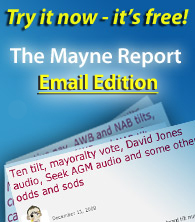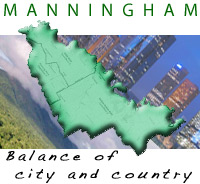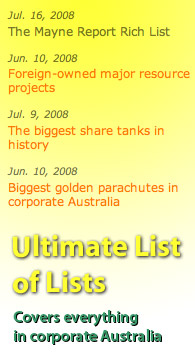AC medals, NSW Gov, News Corp board tilt
July 22, 2008
Here are Stephen Mayne's five stories from the Crikey edition on Tuesday, 20 June, 2006.
1. AC Recipients – The Howard Years
By Stephen Mayne
How open and transparent is Australia's system of gongs? Well, the highest honour possible is the AC – the Companion of the Order of Australia – and there have only been 135 of these dished out over the Howard years. Go through the complete list for yourself and you'll detect a distinct bias in favour of conservative figures and large donors to the Liberal Party.
Indeed, subscriber Brendan Giffney emailed through the following last week: "I congratulated Dick Pratt a few years ago after he received his gong. His honest reply was: 'Why congratulate me. I bought it'."
These are the most obvious ones:
Doug Anthony: former National Party leader
Sir Rod Carnegie: long time Liberal supporter whom Greiner government appointed chair of GIO
Richard Court: former WA Liberal Premier
John Fahey: Howard's first Finance Minister and an average NSW Liberal Premier
Charles Goode: ANZ and Woodside chairman who chairs Liberal Party fundraiser
Dame Margaret Guilfoyle: former Liberal senator from Victoria
Jeff Kennett: former Victorian Premier
James Killen: former Liberal Minister in the Gorton government
Donald McDonald: ABC chairman and close mate of the PM's
Max Moore-Wilton: Long-time Liberal supporter and Howard's first departmental head
Hugh Morgan: former WMC CEO and prominent Liberal fundraiser
Maurice Newman: ASX chairman and old mate of the PM
Andrew Peacock: former Federal Liberal leader and Foreign Minister
Ian Sinclair: former National Party leader
Shane Stone: former Federal Liberal President
Ron Walker: most prolific Liberal bagman in history
And who are the obvious Labor figures? We can only come up with the following:
Jim Bacon: the former Tasmanian premier was gonged posthumously
Richard Butler: former chief UN weapons inspector and Tasmanian governor
Michael Field: former Tasmanian Labor Premier
Then you have the link between donations and gongs which is something we'll be exploring further in the coming days. If the political bias is so obvious, it's hardly a stretch to assume that big cheques for the Liberal Party will smooth the way.
4. NSW tries another sneaky power sale
| |||||
DirectLink, a high-voltage electricity cable linking NSW and Queensland, is to be put up for sale by its owners, prompting a tender process that might raise up to $175 million. It comes amid a flood of deals in the utilities sector as international companies take advantage of high prices to sell out of Australia and local operators compete to lead consolidation of the sector.It wasn't until the sixth paragraph that we got this: DirectLink is a joint venture between TransEnergie, a subsidiary of Canada's Hydro Quebec, and EmmLink, a subsidiary of the NSW government-owned utility Country Energy. It operates the high-voltage 180 megawatt cable linking the NSW and Queensland regions of the national electricity market.Hello! Does anyone else think this is a big political story in NSW? Just two weeks after getting rolled on the controversial Snowy Hydro privatisation, the cash-strapped Iemma Government is going further down the electricity privatisation path. With the Beattie Government flogging gas distributor Allgas and its two electricity retailers, it's clear that the two states with the most government ownership of energy assets are prepared to embrace power privatisation to fund unprecedented infrastructure programs which will require a staggering $35 billion of new borrowings over the next four years. Meanwhile, it might make sense for the NSW media and various politicians to jump on the issue and have a decent public debate about the sale of this latest strategic asset. NSW refused to explain its position on the Snowy float, so let's see if Kremlinesque Treasury Secretary John Pearce is prepared to be a little bit more open this time. |
6. What triggered the Herald Sun's petrol beat-up?
By Stephen Mayne
The Herald Sun, the Federal Parliamentary Library and Labor's Kelvin Thompson all have egg on their faces this morning after they conspired to produce one of the worst page one beat-ups we've seen this year. The headline in yesterday's Hun screamed "$10bn petrol tax steal" and the Michael Harvey splash began as follows:
Motorists have pumped more than $10 billion in GST petrol revenue into government coffers, independent analysis has revealed. That is twice as much as the tax take promised when the GST came in six years ago. The supposed trade-off – cutting excise on petrol – has cost the Federal Government only $4.6 billion in lost revenue since July 1, 2000.Alas, John Howard set the record straight in Question Time yesterday and the Herald Sun was forced to carry a rebuttal on its opinion pages from the PM today along with a mealy mouthed "we were wrong" news story buried on page 16, although neither appears to be online.
Having promised motorists would not be worse off due to the GST, surely it was implausible to think the government could get away with a $5.4 billion tax windfall over just six years when petrol prices are at record highs and the budget is enjoying booming revenues.
Check out page 22 of yesterday's Hansard to see how the PM gently but firmly gave the Herald Sun and its beat-up co-conspirators a cuffing as follows:
The claim being made is false. It is false because in the calculations no allowance has been made for the two discretionary reductions in fuel excise that were made in 2000 and 2001. There was a reduction in excise of 6.7c per litre on the introduction of the GST and there was a further reduction of 1.5c in March 2001, which produces a combined reduction of 8.2c a litre. In addition to that, the abolition of fuel excise indexation in March 2001 has resulted in cumulative savings in relation to excise of something in the order of $1.4 billion.Is it just a coincidence that the News Ltd's biggest selling paper produced its most ill-informed attack on the Howard Government on the same day its spokesman Greg Baxter was all over the media attacking the government for its proposed media ownership reforms?
Having fawned over Herald Sun editor Peter Blunden at his recent tenth anniversary dinner, the PM was careful in the way he delivered the kicking. However, it appears the first public shots have been fired in the emerging war over which mogul the government most supports.
25. Rating the top 20 Australian business figures over 25 years
By Stephen Mayne
Crikey has produced plenty of interesting business lists over the years, including this one on foreign ownership which now includes the legendary buyout firm KKR after yesterday's $1.83 billion purchase of Cleanaway from Brambles.
Another favourite is this list of the 50 most successful Australians in overseas business, which now includes Simon Beresford-Wylie, who will head the $43 billion telecommunications giant that forms when Nokia and Siemens merge their telco network equipment businesses.
However, we've decided to tackle a new business list that will be potentially more interesting, albeit highly subjective – the 20 most successful Australian business figures over the past 25 years.
There will be some definitional debates. Like how do you rate private entrepreneurs against public company CEOs? And should any of the Australians who rose to run foreign multinationals be included?
The three most certain entries will be Rupert Murdoch, Dick Pratt and Frank Lowy – but after that it gets difficult. Should someone like out-going Woolworths CEO Roger Corbett be included when all he really does is efficiently sell other people's products?
The same applies to all those who have prospered with cosy government licences – a group that extends to bank, media and gaming CEOs. Does a mining CEO count when it's not that hard to dig big holes in the ground and flog the processed dirt around the world? And surely we should have a bias in favour of people who innovate and create new products which then prosper on a competitive global stage. Billabong founder Gordon Merchant, CSL's Brian McNamee and Computershare's Chris Morris all fall into that category.
While there are endless numbers of sporting legends, Australia is not known for its business heroes, so this will be a tricky exercise. Your suggestions are encouraged to smayne@crikey.com.au as we'll be publishing my 20 names on Thursday before others will also join the fray.
26. Another tilt at the News Corp board
By Stephen Mayne, nominee for the News Corp board
Here we go again. At 10.45pm AEST last night, News Corporation's New York-based company secretary Laura Oleary was faxed a nomination from yours truly to run for the board at this year's AGM along with a letter of support from a small News Corporation shareholder, one Paula Piccinini.
It's the fourth News Corp nomination in six years but the 2001 and 2005 tilts were both rejected by the company in delphic terms. Laura's brief fax last year simply said it was "not timely". Under US securities law, a board nomination must arrive 65 days before the anniversary of the previous "proxy event". In News Corp's case that was the 2005 proxy statement on 25 August – 67 days from now.
Unfortunately, I won't be able to put up a shareholder resolution calling for an end to Rupert Murdoch's gerrymander this year because you have to own at least $US2000 worth of stock continuously for 12 months to do this. I'm very happy with the 300 News Corp B Class voting shares as the paper profit from the recent recovery has reached $1584, but the majority of these were bought in August and October last year.
However, we still have at least 24 hours for another longer term News Corp shareholder to fax through the following shareholder resolution that strikes right at the heart of Rupert's rorted stranglehold on power:
That the board of News Corporation calls a special meeting of stockholders in both the A and B Class shares within six months of the 2006 AGM to vote on an equitable proposal to merge the two classes of shares to end the current gerrymander that sees only approximately 30% of all shares enjoying full voting rights.Shareholder resolutions are common in America because they don't have Australia's ridiculous 100 signature rule, so check out examples about Boeing in China and Nike's labour record in Indonesia.
At the time of the 2004 reincorporation proposal, stockholders were told US investors would strongly support the stock once it was included in the S&P500 index. Unfortunately, only one class of security is allowed in the S&P and that is the more populous non-voting A Class. Giving A Class stockholders full voting rights would open up control of the company, place 100% of all shares in the S&P500 and lead to a re-rating of the stock that benefited all shareholders.
Given that the A Class non-voting shares are currently trading at a 5% discount to the voting B Class shares, the proposal should include a compensating bonus issue to holders of the B Class shares.
If anyone is interested in stepping up to the plate, please email smayne@crikey.com.au and I'll shoot through the form letter. Alternatively, you can work your own up and fax Laura at 0011 1 212 852 7217, but there's no time for dithering.
Copyright © 2024 The Mayne Report. All rights reserved






















